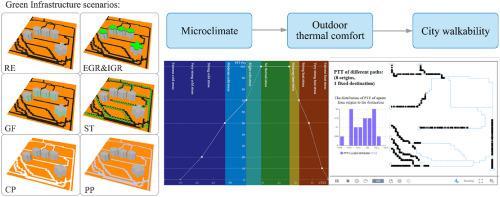Building and Environment ( IF 7.4 ) Pub Date : 2021-05-25 , DOI: 10.1016/j.buildenv.2021.107988 Siqi Jia , Yuhong Wang

|
The effects of six heat mitigation strategies on thermal environment, thermal comfort, and walkability are evaluated. Thermal environment is simulated using a micro-scale computational fluid dynamic (CFD) model—ENVI-met. Thermal comfort is quantified with the Universal Thermal Climate Index (UTCI), which is linked to walkability through agent-based modeling (ABM). These integrated methods enable the quantitative assessment of how heat mitigation strategies used in urban planning affect human perceptions and behaviors. A typical high-density urban area in Hong Kong is used as a case study. Model validation reveals that the CFD model is partially accurate, performing the best in air temperature prediction. The results indicate that the type of infrastructure which causes the greatest reduction in air temperature does not necessarily lead to the biggest improvement in thermal comfort and walkability. Compared with the control, cool pavements reduce peak air temperature by 0.36 , and street trees reduce peak mean radiant temperature by 4.23 . Street trees also result in the lowest values of UTCI during the daytime, with a maximum UTCI reduction of 0.88 . In ABM simulations, street trees cause a reduction in perceived travel time (PTT) of up to 3 s per 100 m. However, the effects of other mitigation measures are marginal. Our findings suggest that although all heat mitigation strategies can be beneficial in improving the urban thermal environment, street trees are the most beneficial for improving thermal comfort and walkability.



























 京公网安备 11010802027423号
京公网安备 11010802027423号